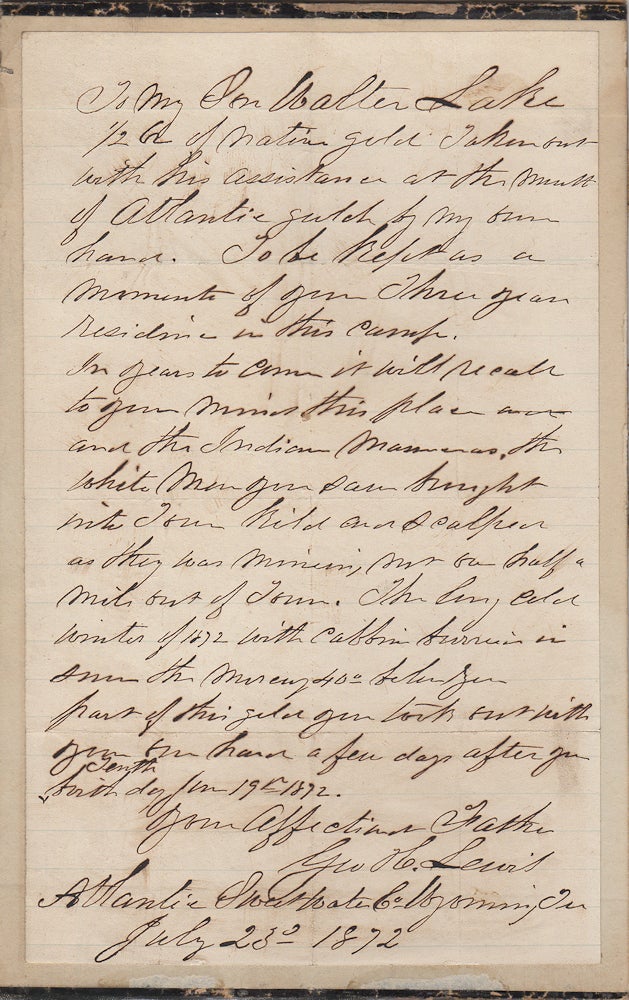WYOMING GOLD MINING MASSACRE LETTER. “In years to come . . . recall to your mind this place and the Indian Massacres, the white men you saw brought into town kild and scalped as they was mining, not one half a mile out of Town.”
Atlantic Gulch, Wyoming: 1872. This manuscript letter measures 5”x8”. It is in nice shape but was laid-down years ago on a period marbled bookboard. There is no mailing envelope since it was given in person by a father to his ten-year-old son along with “½ gr of native gold taken out with his assistance at the mouth of Atlantic Gulch by my own hand” Transcript will be provided.
The letter reads in part
“To be kept as a momento of your Three years’ residence in this camp. In years to come it will recall to your mind this place and the Indian Massacres, the white men you saw brought into town kild and scalped as they was mining, not one half a mile out of Town. The long cold winter of 1872 with cabbin buried in snow the mercury 40 below zero, part of this gold you took out with your own hand a few days after your tenth birthday year Jan. 19th, 1872.”
. Item #009671The Sweet Water region, about 20 miles south of present-day Lander, was the gold mining center of Wyoming from the late 1860s until the mid-1870s. In 1867, a small group of Mormon prospectors found some gold along the banks of Willow (or Rock) Creek just north of the Oregon Trail at the southeastern end of the Wind River Mountains. After a large gold-rich quartz vein—named the Atlantic Ledge due to its location on the east side of the continental divide--that was several feet wide and thousands of feet long, the boom was on and hopeful miners swarmed into the region. Three entrepreneurs platted a town and sold lots to accommodate the prospectors, and Atlantic City was born. In its heyday, about 2,000 people lived in the town which grew to include a church, general store, dance hall, brewery, opera house, school, drug store, and a “French” area with several saloons and brothels.
The “Indian Massacres” Lewis reports occurred in a 23-month span between August 1868 and June 1870. At least twenty miners and homesteaders were killed by the Arapahoe, Sioux, and Cheyenne in the Sweet Water region, and at least that many more were attacked and wounded.
Almost all of the dead suffered horrible peri- or post-mortem mutilations, the most notorious being that of Henry Morgan. The Arapahoes cut sinews from his arms, legs, and back for later use as bowstrings. They also drove a long, heavy bolt from his wagon so deep into his forehead that the undertaker was unable to remove it, and he was buried with it protruding from his skull.
The depredations only stopped after locals publicly requested military assistance from General Sheridan, and sufficient forces from the 7th Infantry and 11th Cavalry established a fort (alternately known as Camp Augur, Camp Brown, and Fort Stambaugh) at what is now Lander, Wyoming.
(For more information, see “Indian Treachery in Wyoming: Massacre of Whites by Peaceful Indians,” New York Herald, 4 Apr 1870, Nickerson’ Scrapbook from Wyoming State Archives Microfilm online at Rootsweb, “Indian Battles of the Sweetwater Mining District” online at Legends of America, Huseas’s Sweetwater Gold. . .,.“Atlantic City” online at UltimateWyoming, and “South Pass Gold Rush” online at WyoHist.org.)
Gold rush letters from Wyoming are far scarcer that those from California or the Dakotas, and it is possible no others beside this one address the massacre of miners.
At the time of this listing no Wyoming gold rush letters are for sale in the trade, and OCLC reports that only two institutions hold any within their collections. There are no auction records for any similar letters at the Rare Book Hub or Worthpoint.
Price: $950.00






